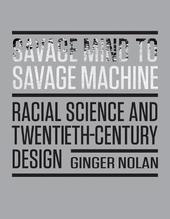
|
Savage Mind to Savage Machine: Racial Science and Twentieth-Century Design
Paperback / softback
Main Details
| Title |
Savage Mind to Savage Machine: Racial Science and Twentieth-Century Design
|
| Authors and Contributors |
By (author) Ginger Nolan
|
| Physical Properties |
| Format:Paperback / softback | | Pages:328 | | Dimensions(mm): Height 254,Width 178 |
|
| Category/Genre | Architecture |
|---|
| ISBN/Barcode |
9781517905866
|
| Classifications | Dewey:701.03 |
|---|
| Audience | | General | | Professional & Vocational | |
|---|
| Illustrations |
74 B-W Illustrations
|
|
Publishing Details |
| Publisher |
University of Minnesota Press
|
| Imprint |
University of Minnesota Press
|
| Publication Date |
29 June 2021 |
| Publication Country |
United States
|
Description
An examination of how concepts of "the savage" facilitated technological approaches to modernist design Attempting to derive aesthetic systems from natural structures of human cognition, designers looked toward the "savage mind"-a way of thinking they associated with a racialized subaltern. In Savage Mind to Savage Machine, Ginger Nolan uncovers an enduring relationship between "the savage" and the development of technology and its wide-ranging impact on society, including in the fields of architecture and urbanism, the industrial arts, and digital design. Nolan focuses on the relationship between the applied arts and the structuralist social sciences, proposing that the late-nineteenth-century rise of Freudian psychology, ethnology, and structuralist linguistics offered innovations and new opportunities in studying human cognition. She looks at institutions ranging from the Public Industrial Arts School of Philadelphia and the Weimar Bauhaus to the MIT Media Lab and the Centre Mondial Informatique, revealing a persistent theme of twentieth-century design: to supplant language with more subliminal, aesthetic modes of communication, thereby inculcating a deep intimacy between human habit and new technologies of production, communication, and consumption. This book's ultimate critique is of the development of the ergonomics of the spirit-the design of the human cognitive apparatus in relation to new aesthetic technologies. Nolan sees these ergonomics as a means of depoliticizing societies through aesthetic technologies intended to seamlessly integrate humans into the programs of capitalist modernity. Revising key modernist design narratives, Savage Mind to Savage Machine provides a deep historical foundation for understanding our contemporary world.
Author Biography
Ginger Nolan is assistant professor of architectural history and theory at the University of Southern California's School of Architecture. She previously published The Neocolonialism of the Global Village in the University of Minnesota Press's Forerunner series.
Reviews"Savage Mind to Savage Machine is a breathtakingly ambitious discussion of 'savage thought' in modern architecture and design-ambitious methodologically, in its move from reductive versions of contextualization towards an epistemology of interdisciplinary aporias, displacements, and contradictions; ambitious historiographically, in its reconstruction of modern architecture as conceptual and political project; and, perhaps most compellingly of all, ambitious in its enmeshment of methodology and historiography towards an entirely new reading of the relation of modern architecture to its supposedly 'savage' counterparts."-Andrew Herscher, University of Michigan "Well-illustrated and persuasively argued, the book mixes historiography and complex theoretical analysis, detecting subtle interplays between design and governance over a long duree. "-Journal of Design History
|